Effect of Hot Rolling on the Microstructure and Mechanical Performance of a Mg-5Sn Alloy
Abstract
:1. Introduction
2. Materials and Methods
3. Results
3.1. Microstructures
3.2. Mechanical Properties
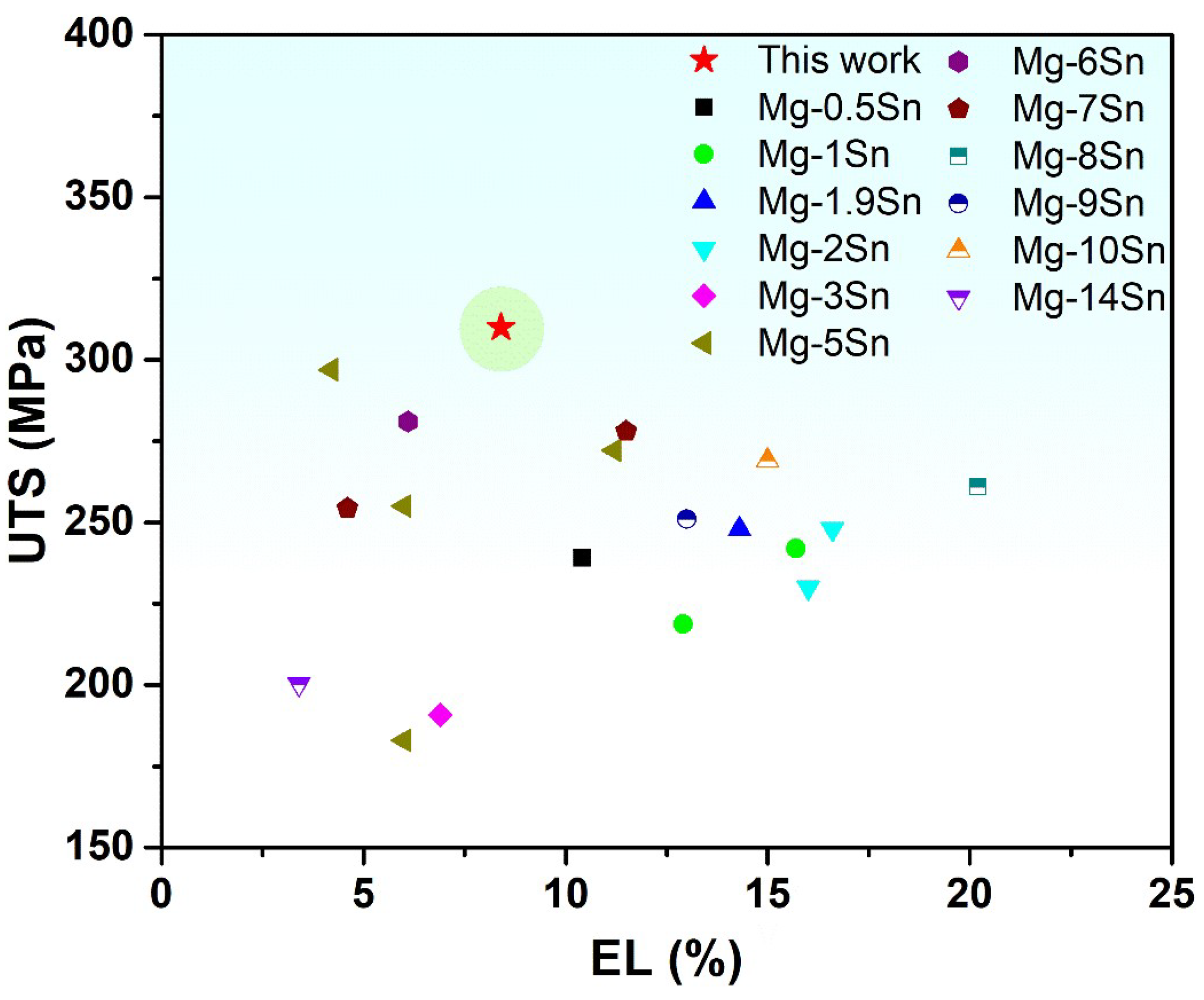
4. Conclusions
Author Contributions
Funding
Conflicts of Interest
References
- Bovand, D.; Abdollah-Pour, H.; Mirzaee, O.; Bagherifard, S. Dry sliding wear and corrosion performance of Mg-Sn-Ti alloys produced by casting and extrusion. Materials 2022, 15, 3533. [Google Scholar] [CrossRef] [PubMed]
- Xu, H.; Li, Y.; Wu, L.; Jiang, F.; Fu, D.; Teng, J.; Zhang, H. Effect of heat treatments on the corrosion resistance of a high strength Mg-Gd-Y-Zn-Zr alloy. Materials 2022, 15, 2813. [Google Scholar] [CrossRef] [PubMed]
- Xu, T.; Yang, Y.; Peng, X.; Song, J.; Pan, F. Overview of advancement and development trend on magnesium alloy. J. Magnes. Alloy. 2019, 7, 536–544. [Google Scholar] [CrossRef]
- Zuo, J.; Zhang, M.; Nakata, T.; Wang, G.; Li, D.; Shi, H.; Xu, C.; Wang, X.; Li, W.; Fan, G.; et al. Effect of Al addition on grain refinement and phase transformation of the Mg-Gd-Y-Zn-Mn alloy containing LPSO phase. Materials 2022, 15, 1632. [Google Scholar] [CrossRef]
- Zhuo, X.R.; Ma, A. Molecular dynamics-based cohesive zone model for Mg/Mg17Al12 interface. Metals 2020, 10, 836. [Google Scholar] [CrossRef]
- Cheah, L.; Heywood, J. Meeting U.S. passenger vehicle fuel economy standards in 2016 and beyond. Energy Policy 2011, 39, 454–466. [Google Scholar] [CrossRef]
- Fu, H.; Guo, J.; Wu, W.; Liu, B.; Peng, Q. High pressure aging synthesis of a hexagonal Mg2Sn strengthening precipitate in Mg-Sn alloys. Mater. Lett. 2015, 157, 172–175. [Google Scholar] [CrossRef]
- Cheng, W.L.; Tian, Q.W.; Yu, H.; Zhang, H.; You, B.S. Strengthening mechanisms of indirect-extruded Mg–Sn based alloys at room temperature. J. Magnes. Alloy. 2014, 2, 299–304. [Google Scholar] [CrossRef]
- Liu, H.; Chen, Y.; Tang, Y.; Wei, S.; Niu, G. The microstructure, tensile properties, and creep behavior of as-cast Mg–(1–10)% Sn alloys. J. Alloy. Compd. 2007, 440, 122–126. [Google Scholar] [CrossRef]
- Liu, C.Q.; Chen, H.W.; Liu, H.; Zhao, X.J.; Nie, J.F. Metastable precipitate phases in Mg–9.8 wt%Sn alloy. Acta Mater. 2018, 144, 590–600. [Google Scholar] [CrossRef]
- Wei, S.-H.; Chen, Y.-G.; Tang, Y.-B.; Liu, M.; Xiao, S.-F.; Zhang, X.-P.; Zhao, Y.-H. Compressive creep behavior of Mg-Sn binary alloy. Trans. Nonferrous Met. Soc. China 2008, 18, S214–S217. [Google Scholar] [CrossRef]
- Wei, S.; Chen, Y.; Tang, Y.; Liu, H.; Mao, S.; Niu, G.; Zhang, X.; Zhao, Y. Compressive creep behavior of as-cast and aging-treated Mg-5 wt% Sn alloys. Mater. Sci. Eng. A-Struct. Mater. Prop. Microstruct. Process. 2008, 492, 20–23. [Google Scholar] [CrossRef]
- Cheng, W.; Bai, Y.; Wang, L.; Wang, H.; Bian, L.; Yu, H. Strengthening effect of extruded Mg-8Sn-2Zn-2Al alloy: Influence of micro and nano-size Mg2Sn precipitates. Materials 2017, 10, 822. [Google Scholar] [CrossRef]
- Chen, D.; Ren, Y.-P.; Guo, Y.; Pei, W.-L.; Zhao, H.-D.; Qin, G.-W. Microstructures and tensile properties of as-extruded Mg-Sn binary alloys. Trans. Nonferrous Met. Soc. China 2010, 20, 1321–1325. [Google Scholar] [CrossRef]
- Cheng, W.L.; Park, S.S.; You, B.S.; Koo, B.H. Microstructure and mechanical properties of binary Mg-Sn alloys subjected to indirect extrusion. Mater. Sci. Eng. A-Struct. Mater. Prop. Microstruct. Process. 2010, 527, 4650–4653. [Google Scholar] [CrossRef]
- Li, W. Compression yield behavior and corresponding microstructure characterization of Mg-1.5Sn (at.%) alloys. Mater. Res. Express 2021, 8, 106502. [Google Scholar] [CrossRef]
- Wan, Y.J.; Zeng, Y.; Zeng, Q.; Song, B.; Huang, X.F.; Qian, X.Y.; Jiang, B. Simultaneously improved strength and toughness of a Mg-Sn alloy through abundant prismatic lath-shaped precipitates. Mater. Sci. Eng. A-Struct. Mater. Prop. Microstruct. Process. 2021, 811, 141087. [Google Scholar] [CrossRef]
- Zhao, C.; Pan, F.; Zhao, S.; Pan, H.; Song, K.; Tang, A. Preparation and characterization of as-extruded Mg-Sn alloys for orthopedic applications. Mater. Des. 2015, 70, 60–67. [Google Scholar] [CrossRef]
- Zhao, C.; Chen, X.; Pan, F.; Gao, S.; Zhao, D.; Liu, X. Effect of Sn content on strain hardening behavior of as-extruded Mg-Sn alloys. Mater. Sci. Eng. A-Struct. Mater. Prop. Microstruct. Process. 2018, 713, 244–252. [Google Scholar] [CrossRef]
- Prasad, S.V.S.; Prasad, S.B.; Verma, K.; Mishra, R.K.; Kumar, V.; Singh, S. The role and significance of Magnesium in modern day research-A review. J. Magnes. Alloy. 2022, 10, 1–61. [Google Scholar] [CrossRef]
- Wang, X.J.; Nie, K.B.; Hu, X.S.; Wang, Y.Q.; Sa, X.J.; Wu, K. Effect of extrusion temperatures on microstructure and mechanical properties of SiCp/Mg-Zn-Ca composite. J. Alloy. Compd. 2012, 532, 78–85. [Google Scholar] [CrossRef]
- Ma, C.-Y.; Xia, N.; Wang, C.; Li, M.-X.; Hua, Z.-M.; Ren, M.-W.; Wang, H.-Y. A novel Mg-5Al-2Zn-2Sn alloy with high strength-ductility synergy fabricated via simple hot rolling and annealing treatment. J. Alloy. Compd. 2021, 869, 159308. [Google Scholar] [CrossRef]
- Nakata, T.; Xu, C.; Ohashi, H.; Yoshida, Y.; Yoshida, K.; Kamado, S. New Mg-Al based alloy sheet with good room-temperature stretch formability and tensile properties. Scr. Mater. 2020, 180, 16–22. [Google Scholar] [CrossRef]
- Guo, F.; Zhang, D.; Wu, H.; Jiang, L.; Pan, F. The role of Al content on deformation behavior and related texture evolution during hot rolling of Mg-Al-Zn alloys. J. Alloy. Compd. 2017, 695, 396–403. [Google Scholar] [CrossRef]
- Guo, F.; Zhang, D.; Yang, X.; Jiang, L.; Chai, S.; Pan, F. Effect of rolling speed on microstructure and mechanical properties of AZ31 Mg alloys rolled with a wide thickness reduction range. Mater. Sci. Eng. A-Struct. Mater. Prop. Microstruct. Process. 2014, 619, 66–72. [Google Scholar] [CrossRef]
- Jin, L.; Dong, J.; Wang, R.; Peng, L.M. Effects of hot rolling processing on microstructures and mechanical properties of Mg-3%Al-1%Zn alloy sheet. Mater. Sci. Eng. A-Struct. Mater. Prop. Microstruct. Process. 2010, 527, 1970–1974. [Google Scholar] [CrossRef]
- Wang, J.; Dong, H.; Wang, L.; Wu, Y.; Wang, L. Effect of hot rolling on the microstructure and mechanical properties of Mg-5Al-0.3Mn-2Nd alloy. J. Alloy. Compd. 2010, 507, 178–183. [Google Scholar] [CrossRef]
- Wu, S.; Zhang, J.; Zhang, Z.; Xu, C.; Nie, K.; Niu, X. A high strength and good ductility Mg-Y-NI-TI alloy with long period stacking ordered structure processed by hot rolling and aging treatment. Mater. Sci. Eng. A-Struct. Mater. Prop. Microstruct. Process. 2015, 648, 134–139. [Google Scholar] [CrossRef]
- Xu, S.; Zhu, C.; Lin, Z.; Jin, C.; Kamado, S.; Oh-ishi, K.; Qin, Y. Dynamic microstructure evolution and mechanical properties of dilute Mg-Al-Ca-Mn alloy during hot rolling. J. Mater. Sci. Technol. 2022, 129, 1–14. [Google Scholar] [CrossRef]
- Liu, H.; Sun, C.; Wang, C.; Li, Y.; Bai, J.; Xue, F.; Ma, A.; Jiang, J. Improving toughness of a Mg2Ca-containing Mg-Al-Ca-Mn alloy via refinement and uniform dispersion of Mg2Ca particles. J. Mater. Sci. Technol. 2020, 59, 61–71. [Google Scholar] [CrossRef]
- Poddar, P.; Bagui, S.; Ashok, K.; Murugesan, A.P. Experimental investigation on microstructure and mechanical properties of gravity-die-cast magnesium alloys. J. Alloy. Compd. 2017, 695, 895–908. [Google Scholar] [CrossRef]
- Nayyeri, G.; Mahmudi, R. Enhanced creep properties of a cast Mg-5Sn alloy subjected to aging-treatment. Mater. Sci. Eng. A-Struct. Mater. Prop. Microstruct. Process. 2010, 527, 4613–4618. [Google Scholar] [CrossRef]
- Zhuo, X.; Shao, C.; Zhang, P.; Hu, Z.; Liu, H. Effect of equal channel angular pressing on the microstructure and mechanical properties of an Mg–5Sn Alloy. Metals 2022, 12, 1341. [Google Scholar] [CrossRef]
- Rui, S.-S.; Han, Q.-N.; Wang, X.; Li, S.; Ma, X.; Su, Y.; Cai, Z.; Du, D.; Shi, H.-J. Correlations between two EBSD-based metrics Kernel Average Misorientation and Image Quality on indicating dislocations of near-failure low alloy steels induced by tensile and cyclic deformations. Mater. Today Commun. 2021, 27, 102445. [Google Scholar] [CrossRef]
- Kamaya, M.; Sakakibara, Y.; Yoda, R.; Suzuki, S.; Morita, H.; Kobayashi, D.; Yamagiwa, K.; Nishioka, T.; Maekawa, Y.; Tanakamaru, T.; et al. A round robin EBSD measurement for quantitative assessment of small plastic strain. Mater. Charact. 2020, 170, 110662. [Google Scholar] [CrossRef]
- Huang, K.; Loge, R.E. A review of dynamic recrystallization phenomena in metallic materials. Mater. Des. 2016, 111, 548–574. [Google Scholar] [CrossRef]
- Sasaki, T.T.; Yamamoto, K.; Honma, T.; Kamado, S.; Hono, K. A high-strength Mg-Sn-Zn-Al alloy extruded at low temperature. Scr. Mater. 2008, 59, 1111–1114. [Google Scholar] [CrossRef]
- Kim, B.; Baek, S.-M.; Jeong, H.Y.; Lee, J.G.; Park, S.S. Grain refinement and reduced yield asymmetry of extruded Mg-5Sn-1Zn alloy by Al addition. J. Alloy. Compd. 2016, 660, 304–309. [Google Scholar] [CrossRef]
- Zhuo, X.; Wu, Y.; Ju, J.; Liu, H.; Jiang, J.; Hu, Z.; Bai, J.; Xue, F. Recent progress of novel biodegradable zinc alloys: From the perspective of strengthening and toughening. J. Mater. Res. Technol-JMRT 2022, 17, 244–269. [Google Scholar] [CrossRef]
- Hansen, N. Hall-Petch relation and boundary strengthening. Scr. Mater. 2004, 51, 801–806. [Google Scholar] [CrossRef]
- Zhang, X.; Hansen, N.; Gao, Y.; Huang, X. Hall-Petch and dislocation strengthening in graded nanostructured steel. Acta Mater. 2012, 60, 5933–5943. [Google Scholar] [CrossRef]
- El Mahallawy, N.; Diaa, A.A.; Akdesir, M.; Palkowski, H. Effect of Zn addition on the microstructure and mechanical properties of cast, rolled and extruded Mg-6Sn-xZn alloys. Mater. Sci. Eng. A-Struct. Mater. Prop. Microstruct. Process. 2017, 680, 47–53. [Google Scholar] [CrossRef]
- Pan, H.; Qin, G.; Xu, M.; Fu, H.; Ren, Y.; Pan, F.; Gao, Z.; Zhao, C.; Yang, Q.; She, J.; et al. Enhancing mechanical properties of Mg-Sn alloys by combining addition of Ca and Zn. Mater. Des. 2015, 83, 736–744. [Google Scholar] [CrossRef]
- Jayalakshmi, S.; Sankaranarayanan, S.; Koh, S.P.X.; Gupta, M. Effect of Ag and Cu trace additions on the microstructural evolution and mechanical properties of Mg-5Sn alloy. J. Alloy. Compd. 2013, 565, 56–65. [Google Scholar] [CrossRef]
- Qian, X.Y.; Zeng, Y.; Jiang, B.; Yang, Q.R.; Wan, Y.J.; Quan, G.F.; Pan, F.S. Grain refinement mechanism and improved mechanical properties in Mg-Sn alloy with trace Y addition. J. Alloy. Compd. 2020, 820, 153122. [Google Scholar] [CrossRef]
- Chai, Y.; Jiang, B.; Song, J.; Liu, B.; Huang, G.; Zhang, D.; Pan, F. Effects of Zn and Ca addition on microstructure and mechanical properties of as-extruded Mg-1.0Sn alloy sheet. Mater. Sci. Eng. A-Struct. Mater. Prop. Microstruct. Process. 2019, 746, 82–93. [Google Scholar] [CrossRef]
- Liao, H.; Kim, J.; Liu, T.; Tang, A.; She, J.; Peng, P.; Pan, F. Effects of Mn addition on the microstructures, mechanical properties and work-hardening of Mg-1Sn alloy. Mater. Sci. Eng. A-Struct. Mater. Prop. Microstruct. Process. 2019, 754, 778–785. [Google Scholar] [CrossRef]
- Zhang, J.; Liu, B.; Jiang, B.; Yang, H.; Zhou, G.; Dai, J.; Pan, F. Role of secondary phase in microstructural stability of as-extruded Mg-Sn-Ca at high temperature. Mater. Sci. Technol. 2016, 32, 1818–1825. [Google Scholar] [CrossRef]
- Yu, H.; Xin, Y.; Wang, M.; Liu, Q. Hall-Petch relationship in Mg alloys: A review. J. Mater. Sci. Technol. 2018, 34, 248–256. [Google Scholar] [CrossRef]
- Guan, K.; Yang, Q.; Bu, F.; Qiu, X.; Sun, W.; Zhang, D.; Zheng, T.; Niu, X.; Liu, X.; Meng, J. Microstructures and mechanical properties of a high-strength Mg-3.5Sm-0.6Zn-0.5Zr alloy. Mater. Sci. Eng. A-Struct. Mater. Prop. Microstruct. Process. 2017, 703, 97–107. [Google Scholar] [CrossRef]
- Bailey, J.; Hirsch, P.J.P.M. The dislocation distribution, flow stress, and stored energy in cold-worked polycrystalline silver. Philos. Mag. 1960, 5, 485–497. [Google Scholar] [CrossRef]
- Caceres, C.H.; Lukac, P. Strain hardening behaviour and the Taylor factor of pure magnesium. Philos. Mag. 2008, 88, 977–989. [Google Scholar] [CrossRef]
- Wan, Y.; Tang, B.; Gao, Y.; Tang, L.; Sha, G.; Zhang, B.; Liang, N.; Liu, C.; Jiang, S.; Chen, Z.; et al. Bulk nanocrystalline high-strength magnesium alloys prepared via rotary swaging. Acta Mater. 2020, 200, 274–286. [Google Scholar] [CrossRef]
- Ma, X.; Huang, C.; Moering, J.; Ruppert, M.; Hoeppel, H.W.; Goeken, M.; Narayan, J.; Zhu, Y. Mechanical properties of copper/bronze laminates: Role of interfaces. Acta Mater. 2016, 116, 43–52. [Google Scholar] [CrossRef]
- Sun, W.T.; Qiao, X.G.; Zheng, M.Y.; Xu, C.; Kamado, S.; Zhao, X.J.; Chen, H.W.; Gao, N.; Starink, M.J. Altered ageing behaviour of a nanostructured Mg-8.2Gd-3.8Y-1.0Zn-0.4Zr alloy processed by high pressure torsion. Acta Mater. 2018, 151, 260–270. [Google Scholar] [CrossRef]
- Huang, S.H. Microstructure and Mechanical Properties of a Ag Micro-Alloyed Mg-5Sn Alloy. J. Mater. Eng. Perform. 2018, 27, 3199–3205. [Google Scholar] [CrossRef]
- Zhang, Z.; Zhang, J.; Xie, J.; Liu, S.; He, Y.; Guan, K.; Wu, R. Developing a low-alloyed fine-grained Mg alloy with high strength-ductility based on dislocation evolution and grain boundary segregation. Scr. Mater. 2022, 209, 114414. [Google Scholar] [CrossRef]
- Zhang, Z.; Zhang, J.-H.; Wang, J.; Li, Z.-H.; Xie, J.-S.; Liu, S.-J.; Guan, K.; Wu, R.-Z. Toward the development of Mg alloys with simultaneously improved strength and ductility by refining grain size via the deformation process. Int. J. Miner. Metall. Mater. 2021, 28, 30–45. [Google Scholar] [CrossRef]
- Wei, X.; Jin, L.; Wang, F.; Li, J.; Ye, N.; Zhang, Z.; Dong, J. High strength and ductility Mg-8Gd-3Y-0.5Zr alloy with bimodal structure and nano-precipitates. J. Mater. Sci. Technol. 2020, 44, 19–23. [Google Scholar] [CrossRef]
- Zhuo, X.; Zhang, Q.; Liu, H.; Hu, Z.; Zhang, P.; Jiang, J.; Ma, A.; Wu, Y. Enhanced tensile strength and ductility of an Al-6Si-3Cu alloy processed by room temperature rolling. J. Alloy. Compd. 2022, 899, 163321. [Google Scholar] [CrossRef]
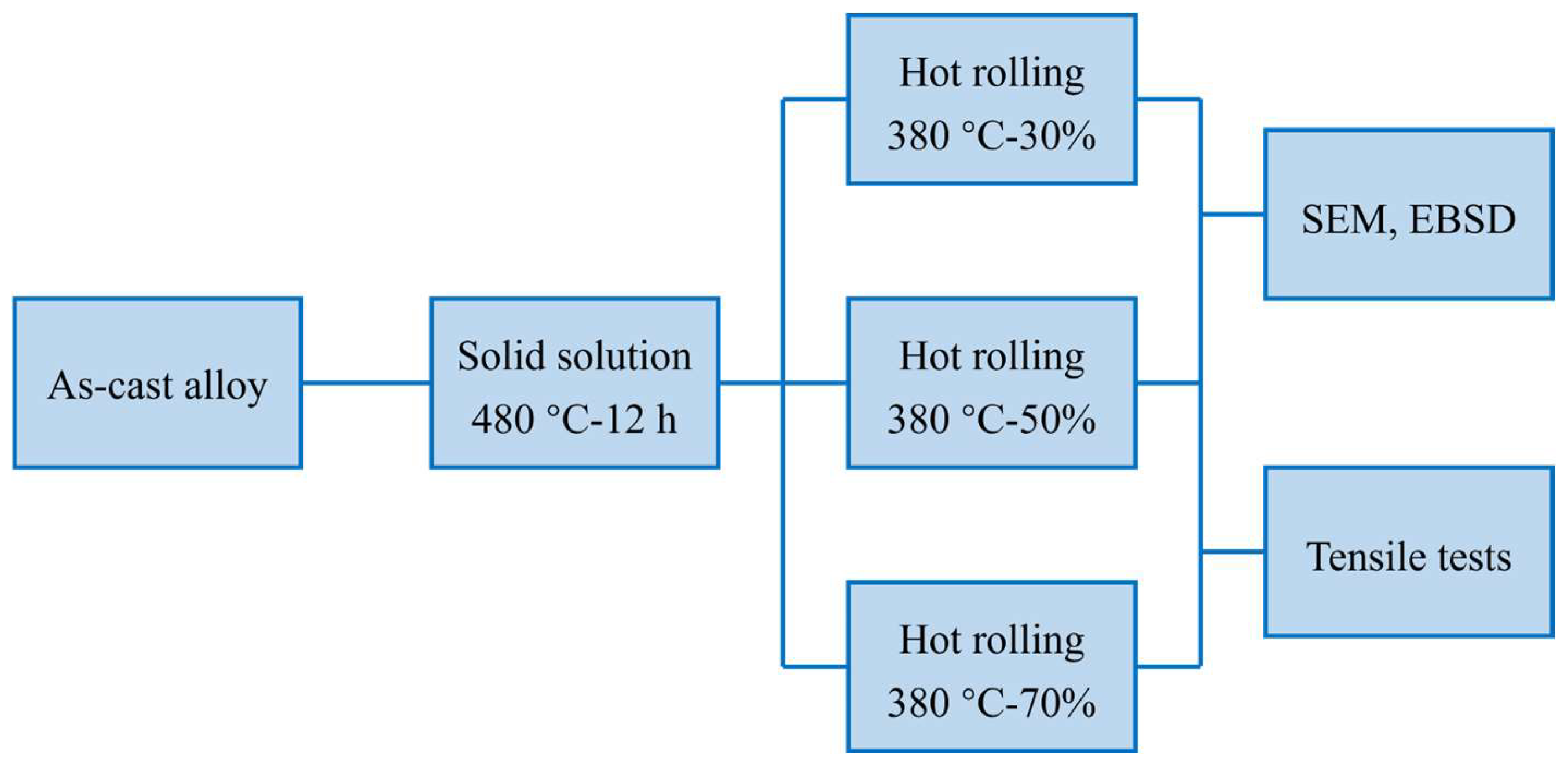

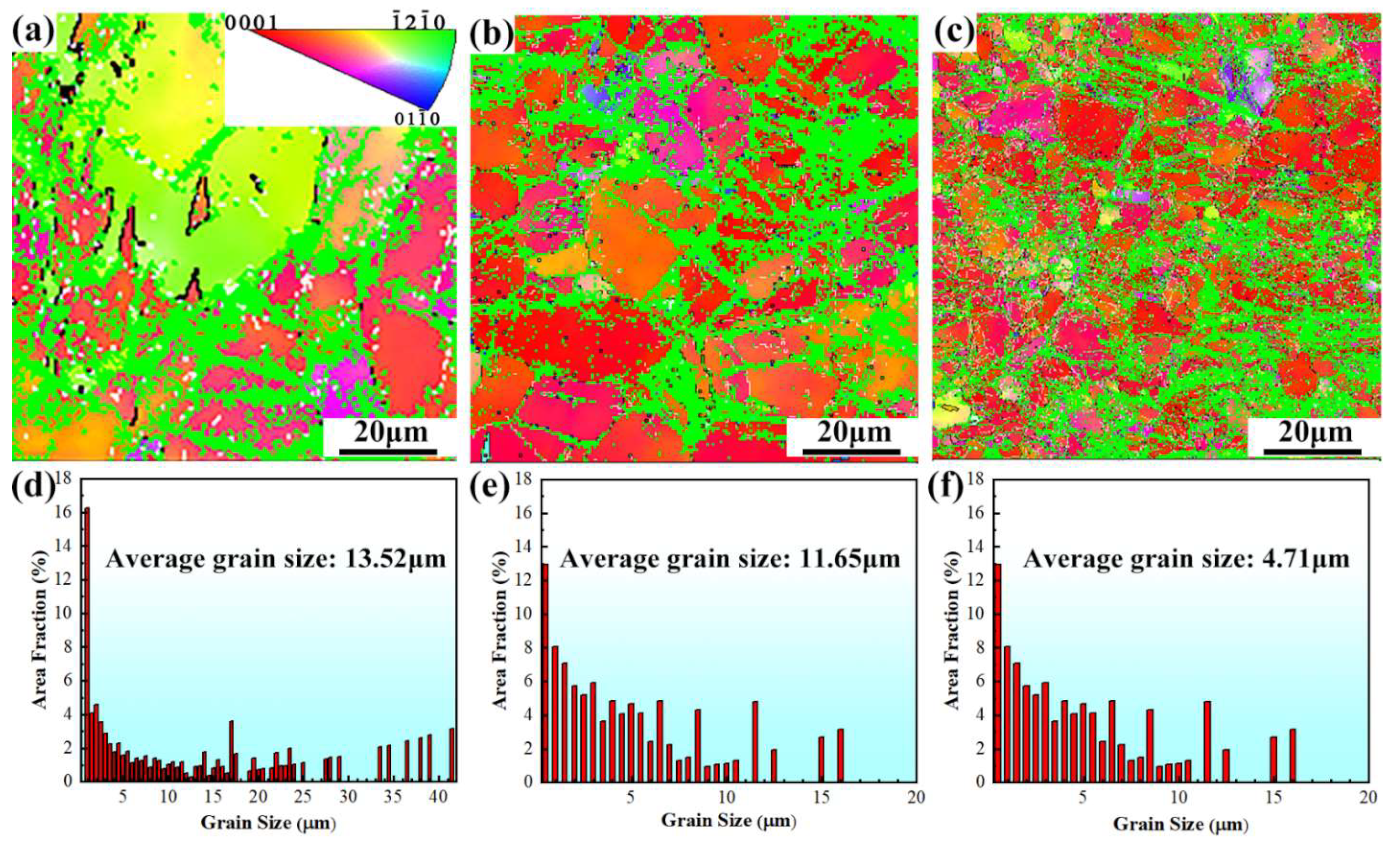
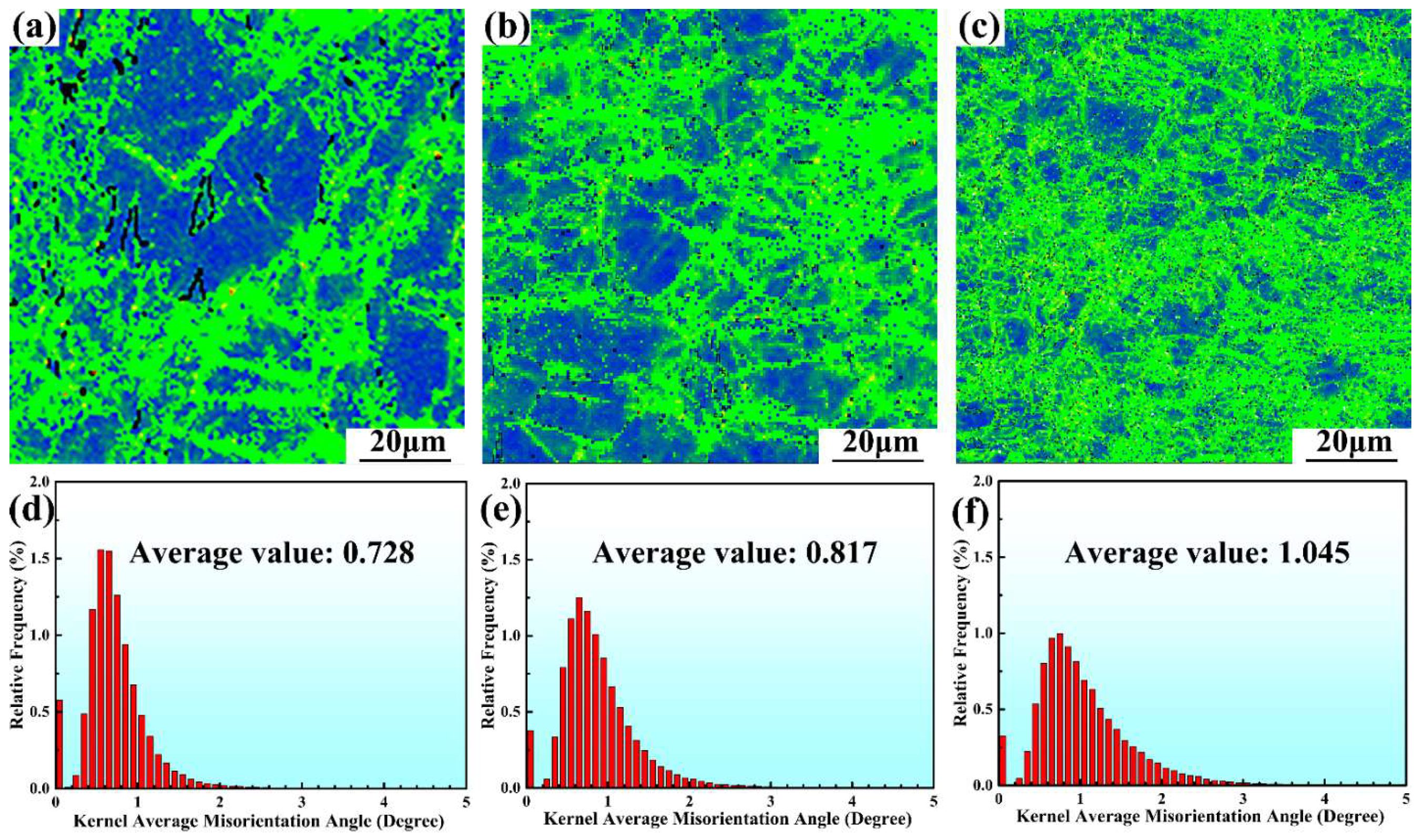
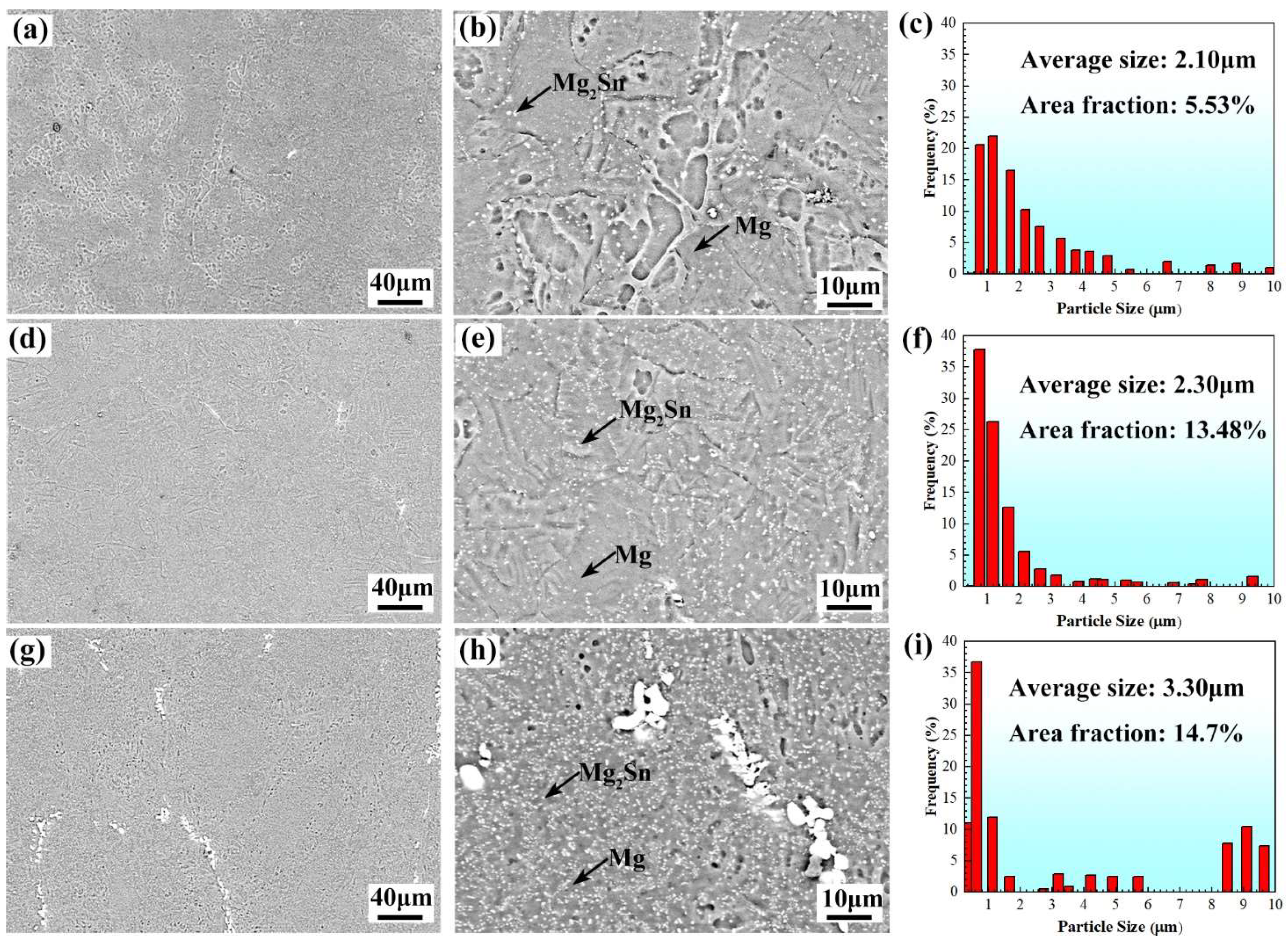

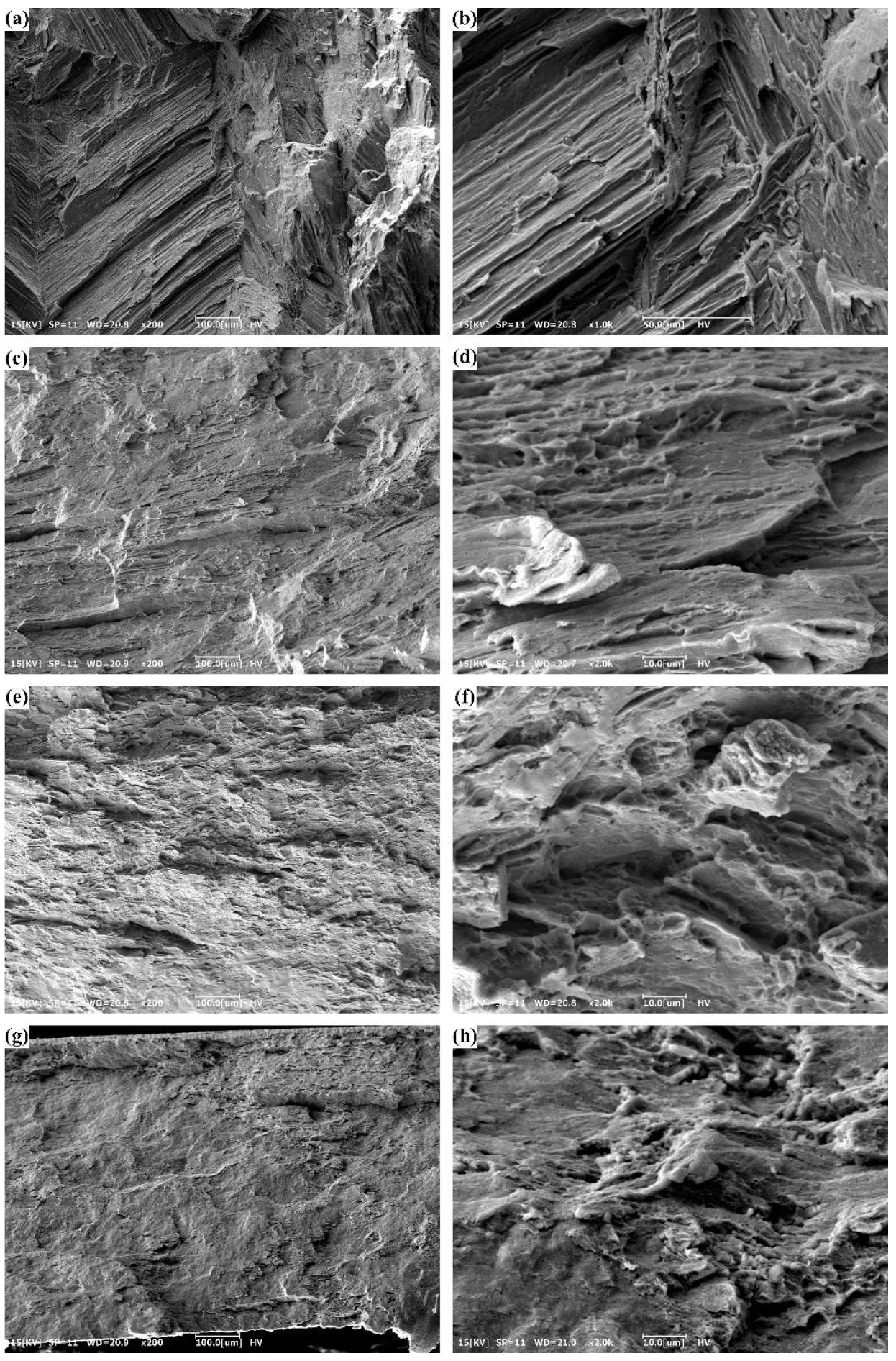
| Alloys | YS (MPa) | UTS (MPa) | EL (%) |
|---|---|---|---|
| As-cast alloy | 31 | 133 | 9.8 |
| R30 alloy | 105 | 213 | 14.1 |
| R50 alloy | 123 | 252 | 10.5 |
| R70 alloy | 191 | 310 | 8.4 |
Publisher’s Note: MDPI stays neutral with regard to jurisdictional claims in published maps and institutional affiliations. |
© 2022 by the authors. Licensee MDPI, Basel, Switzerland. This article is an open access article distributed under the terms and conditions of the Creative Commons Attribution (CC BY) license (https://creativecommons.org/licenses/by/4.0/).
Share and Cite
Zhuo, X.; Shao, C.; Zhang, P.; Hu, Z.; Liu, H. Effect of Hot Rolling on the Microstructure and Mechanical Performance of a Mg-5Sn Alloy. Materials 2022, 15, 5973. https://doi.org/10.3390/ma15175973
Zhuo X, Shao C, Zhang P, Hu Z, Liu H. Effect of Hot Rolling on the Microstructure and Mechanical Performance of a Mg-5Sn Alloy. Materials. 2022; 15(17):5973. https://doi.org/10.3390/ma15175973
Chicago/Turabian StyleZhuo, Xiaoru, Cong Shao, Peng Zhang, Zhichao Hu, and Huan Liu. 2022. "Effect of Hot Rolling on the Microstructure and Mechanical Performance of a Mg-5Sn Alloy" Materials 15, no. 17: 5973. https://doi.org/10.3390/ma15175973







